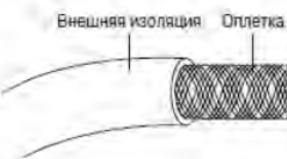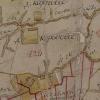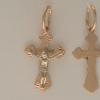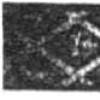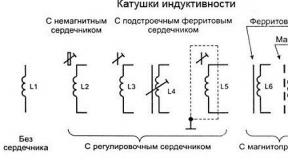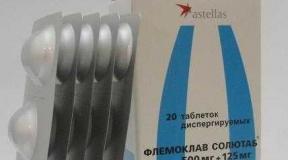The cell theory has been developed. The history of the creation of cell theory. Significance of cell theory
1. Give definitions of concepts.
Cell- an elementary unit of the structure and life of all organisms, having its own metabolism, capable of independent existence, self-reproduction and development.
Organoid- a permanent specialized structure in the cells of living organisms that performs certain functions.
Cytology- a branch of biology that studies living cells, their organelles, their structure, functioning, processes of cell reproduction, aging and death.
2. Distribute the names of scientists from the above list (the list is redundant) according to the corresponding columns of the table.
R. Brown, K. Baer, R. Virchow, K. Galen, K. Golgi, R. Hooke, C. Darwin, A. Leeuwenhoek, K. Linnaeus, G. Mendel, T. Schwann, M. Schleiden.
Scientists who contributed to the development of knowledge about the cell
3. Fill in the left column of the table.
HISTORY OF THE STUDY OF THE CELL

4. Specify the features common to all cells. Explain what properties of living matter make all cells have common characteristics.
All cells are surrounded by a membrane, their genetic information is stored in genes, proteins are their main structural material and biocatalysts, they are synthesized on ribosomes, and cells use ATP as an energy source. All cells are open systems. They are characterized by growth and development, reproduction and irritability.
5. What is the significance of the cell theory for biological science?
The cell theory led to the conclusion about the similarity chemical composition of all cells, the general plan of their structure, which confirms the phylogenetic unity of the entire living world. Modern cytology, having absorbed the achievements of genetics, molecular biology, biochemistry, has turned into cell biology.
7. Fill in the missing terms.
Human erythrocytes have the shape of a biconcave disc.
The composition of the bone tissue includes large osteocytes with numerous processes. Blood leukocytes do not have a permanent shape. The cells of the nervous tissue, which have the ability to excitability and conductivity, are very diverse.
8. Cognitive task.
The first description of a cell was published in 1665. In 1675, unicellular organisms became known. The cell theory was formulated in 1839. Why does the date of the birth of cytology coincide with the time of the formulation of the cell theory, and not with the discovery of the cell?
Cytology is a branch of biology that studies organelles, their structure, functioning, processes of cell reproduction, aging and death in a cell. At the time of discovery of the cell, the cell wall was described. Further, the first cells were discovered, but their structure and functions were not known. Knowledge was not enough, they were analyzed by T. T. Schwann, M. Schleiden, and they created a cellular theory.
9. Choose the correct answer.
Test 1
The cellular structure has:
1) iceberg;
2) tulip petal;
3) hemoglobin protein;
4) a bar of soap.
Test 2
The authors of the cell theory are:
1) R. Hooke and A. Leeuwenhoek;
2) M. Schleiden and T. Schwann;
3) L. Pasteur and I. I. Mechnikov;
4) C. Darwin and A. Wallace.
Test 3
What position of the cell theory belongs to R. Virchow?
1) Cell - the elementary unit of the living;
2) every cell comes from another cell;
3) all cells are similar in their chemical composition;
4) a similar cellular structure of organisms is evidence of the common origin of all living things.
10. Explain the origin and general meaning of the word (term), based on the meaning of the roots that make it up.

11. Choose a term and explain how its modern meaning corresponds to the original meaning of its roots.
Cytology- originally meant the study of the structure and functions of the cell. Later, cytology turned into an extensive branch of biology, became more practical and applied, but the essence of the term remained the same - the study of the cell and its functions.
12. Formulate and write down the main ideas of § 2.1.
People learned about the existence of cells after the invention of the microscope. The first primitive microscope was invented by Z. Jansen.
R. Hooke discovered cork cells.
A. Van Leeuwenhoek, having improved the microscope, observed living cells and described bacteria.
K. Baer discovered the egg of mammals.
The nucleus was discovered in plant cells by R. Brown.
M. Schleiden and T. Schwann were the first to formulate the cell theory. “All organisms consist of the simplest particles - cells, and each cell is an independent whole. In the body, cells act together, forming a harmonious unity.
R. Virchow substantiated that all cells are formed from other cells by cell division.
By the end of the XIX century. the structural components of cells and the process of their division were discovered and studied. The emergence of cytology.
The main provisions of modern cell theory:
a cell is a structural and functional unit of all living organisms, as well as a unit of development;
cells have a membrane structure;
nucleus - the main part of the eukaryotic cell;
cells multiply only by division;
The cellular structure of organisms indicates that plants and animals have a common origin.
 The history of the creation of the cellular theory Hooke (Hooke) Robert (July 18, 1635, Freshwater, Wight - March 3, 1703, London) The first person to see cells was the English scientist Robert Hooke (known to us thanks to Hooke's law). In 1665, trying to understand why the cork tree floats so well, Hooke began to examine thin sections of cork using a microscope he had improved. He found that the cork was divided into many tiny cells, similar to honeycombs, built from cells that reminded him of monastic cells, and he called these cells cells (in English, cell means "cell, cell, cell"). In fact, Robert Hooke saw only the shells of plant cells. This is what the cells looked like under Hooke's microscope.
The history of the creation of the cellular theory Hooke (Hooke) Robert (July 18, 1635, Freshwater, Wight - March 3, 1703, London) The first person to see cells was the English scientist Robert Hooke (known to us thanks to Hooke's law). In 1665, trying to understand why the cork tree floats so well, Hooke began to examine thin sections of cork using a microscope he had improved. He found that the cork was divided into many tiny cells, similar to honeycombs, built from cells that reminded him of monastic cells, and he called these cells cells (in English, cell means "cell, cell, cell"). In fact, Robert Hooke saw only the shells of plant cells. This is what the cells looked like under Hooke's microscope.
 The history of the creation of the cell theory Leeuwenhoek, Anthony van (October 24, 1632, Delft - August 26, 1723, ibid.), Dutch naturalist. Purkyne Jan Evangelista (December 17, 1787, Libochovice - July 28, 1869, Prague), Czech physiologist. Brown, Robert (21. 12. 1773, Montrose - 10. 06. 1858, London), Scottish botanist a drop of water "animals" - moving living organisms - unicellular organisms (bacteria). The first microscopists, following Hooke, paid attention only to cell membranes. It is not difficult to understand them. Microscopes at that time were imperfect and gave low magnification. For a long time, the shell was considered the main structural component of the cell. Only in 1825, the Czech scientist J. Purkinė (1787-1869) drew attention to the semi-liquid gelatinous contents of cells and called it protoplasm (now it is called cytoplasm). Only in 1833, the English botanist R. Brown (1773 -1858), the discoverer of the chaotic thermal motion of particles (later called Brownian in his honor), discovered nuclei in cells. Brown in those years was interested in the structure and development of outlandish plants - tropical orchids. He made sections of these plants and examined them with a microscope. Brown first noticed some strange, undescribed spherical structures in the center of the cells. He called this cell structure the nucleus.
The history of the creation of the cell theory Leeuwenhoek, Anthony van (October 24, 1632, Delft - August 26, 1723, ibid.), Dutch naturalist. Purkyne Jan Evangelista (December 17, 1787, Libochovice - July 28, 1869, Prague), Czech physiologist. Brown, Robert (21. 12. 1773, Montrose - 10. 06. 1858, London), Scottish botanist a drop of water "animals" - moving living organisms - unicellular organisms (bacteria). The first microscopists, following Hooke, paid attention only to cell membranes. It is not difficult to understand them. Microscopes at that time were imperfect and gave low magnification. For a long time, the shell was considered the main structural component of the cell. Only in 1825, the Czech scientist J. Purkinė (1787-1869) drew attention to the semi-liquid gelatinous contents of cells and called it protoplasm (now it is called cytoplasm). Only in 1833, the English botanist R. Brown (1773 -1858), the discoverer of the chaotic thermal motion of particles (later called Brownian in his honor), discovered nuclei in cells. Brown in those years was interested in the structure and development of outlandish plants - tropical orchids. He made sections of these plants and examined them with a microscope. Brown first noticed some strange, undescribed spherical structures in the center of the cells. He called this cell structure the nucleus.
 The history of the creation of the cellular theory Schleiden Matthias Jakob (04/05/1804, Hamburg - 06/23/1881, Frankfurt am Main), German botanist. At the same time, the German botanist M. Schleiden established that plants have a cellular structure. It was Brown's discovery that served as the key to Schleiden's discovery. The fact is that cell membranes, especially young ones, are often poorly visible under a microscope. Another thing is the core. It is easier to detect the nucleus, and then the cell membrane. Schleiden took advantage of this. He began to methodically go through sections after sections, looking for nuclei, then shells, repeating everything over and over again on sections of various organs and parts of plants. After nearly five years of methodical research, Schleiden completed his work. He convincingly proved that all plant organs are of a cellular nature. Schleiden substantiated his theory for plants. But there were still animals. What is their structure, is it possible to speak of a single law of cellular structure for all living things? After all, along with studies that proved the cellular structure of animal tissues, there were works in which this conclusion was sharply disputed. Making sections of bones, teeth and a number of other tissues of animals, scientists did not see any cells. Were they made up of cells before? How did they change? The answer to these questions was given by another German scientist - T. Schwann, who created the cellular theory of the structure of animal tissues. Schwann prompted this discovery, Schleiden gave Schwann a good compass - the core. Schwann used the same technique in his work - first look for the nuclei of cells, then their membranes. In a record short time - in just a year - Schwann completed his titanic work and already in 1839: published the results in the work "Microscopic studies on the correspondence in the structure and growth of animals and plants", where he formulated the main provisions of the cell theory Schwann (Schwann) Theodor ( 07. 12. 1810, Neuss - 11. 01. 1882, Cologne), German physiologist.
The history of the creation of the cellular theory Schleiden Matthias Jakob (04/05/1804, Hamburg - 06/23/1881, Frankfurt am Main), German botanist. At the same time, the German botanist M. Schleiden established that plants have a cellular structure. It was Brown's discovery that served as the key to Schleiden's discovery. The fact is that cell membranes, especially young ones, are often poorly visible under a microscope. Another thing is the core. It is easier to detect the nucleus, and then the cell membrane. Schleiden took advantage of this. He began to methodically go through sections after sections, looking for nuclei, then shells, repeating everything over and over again on sections of various organs and parts of plants. After nearly five years of methodical research, Schleiden completed his work. He convincingly proved that all plant organs are of a cellular nature. Schleiden substantiated his theory for plants. But there were still animals. What is their structure, is it possible to speak of a single law of cellular structure for all living things? After all, along with studies that proved the cellular structure of animal tissues, there were works in which this conclusion was sharply disputed. Making sections of bones, teeth and a number of other tissues of animals, scientists did not see any cells. Were they made up of cells before? How did they change? The answer to these questions was given by another German scientist - T. Schwann, who created the cellular theory of the structure of animal tissues. Schwann prompted this discovery, Schleiden gave Schwann a good compass - the core. Schwann used the same technique in his work - first look for the nuclei of cells, then their membranes. In a record short time - in just a year - Schwann completed his titanic work and already in 1839: published the results in the work "Microscopic studies on the correspondence in the structure and growth of animals and plants", where he formulated the main provisions of the cell theory Schwann (Schwann) Theodor ( 07. 12. 1810, Neuss - 11. 01. 1882, Cologne), German physiologist.
 The history of the creation of the cellular theory The main provisions of the cellular theory according to M. Schleiden and T. Schwann 1. All organisms consist of the same parts - cells; they form and grow according to the same laws. 2. General principle development for the elementary parts of the body - cell formation. 3. Each cell within certain boundaries is an individual, a kind of independent whole. But these individuals act together so that a harmonious whole emerges. All tissues are made up of cells. 4. The processes that occur in plant cells can be reduced to the following: 1) the emergence of new cells; 2) increase in cells in size; 3) transformation of cellular contents and thickening of the cell wall. After that, the fact of the cellular structure of all living organisms became indisputable. Further research showed that it is possible to find organisms that consist of a huge number of cells; organisms consisting of a limited number of cells; finally, those whose entire body is represented by just one cell. Cell-free organisms do not exist in nature. T. Schwann and M. Schleiden erroneously believed that cells in the body arise from the primary non-cellular substance.
The history of the creation of the cellular theory The main provisions of the cellular theory according to M. Schleiden and T. Schwann 1. All organisms consist of the same parts - cells; they form and grow according to the same laws. 2. General principle development for the elementary parts of the body - cell formation. 3. Each cell within certain boundaries is an individual, a kind of independent whole. But these individuals act together so that a harmonious whole emerges. All tissues are made up of cells. 4. The processes that occur in plant cells can be reduced to the following: 1) the emergence of new cells; 2) increase in cells in size; 3) transformation of cellular contents and thickening of the cell wall. After that, the fact of the cellular structure of all living organisms became indisputable. Further research showed that it is possible to find organisms that consist of a huge number of cells; organisms consisting of a limited number of cells; finally, those whose entire body is represented by just one cell. Cell-free organisms do not exist in nature. T. Schwann and M. Schleiden erroneously believed that cells in the body arise from the primary non-cellular substance.
 The history of the creation of the cell theory Virchow Rudolf Ludwig Karl (13.10.1821, Schifelbein, Pomerania - 05.09.1902, Berlin) Baer Karl Maksimovich (17/28.2.1792, Piib estate - 16/28.11 1876, Tartu) Schleiden (Schleiden) Matthias Jakob (04/05/1804, Hamburg - 06/23/1881, Frankfurt am Main) Later Rudolf Vikhrov (in 1858) formulated one of the most important provisions of the cell theory: a cell comes from another cell ... Where a cell arises, it must be preceded by a cell, just as an animal comes only from an animal, a plant only from a plant. A cell can arise only from a previous cell as a result of its division. Academician Russian Academy Sciences Karl Baer discovered the mammalian egg and found that all multicellular organisms begin their development from a single cell. This discovery showed that the cell is not only a unit of structure, but also a unit of development of all living organisms. The idea that all organisms are built from cells was one of the most important theoretical advances in the history of biology, as it provided a unified framework for the study of all living beings. The zoologist Schleiden first described in 1873 the indirect division of animal cells - "mitosis".
The history of the creation of the cell theory Virchow Rudolf Ludwig Karl (13.10.1821, Schifelbein, Pomerania - 05.09.1902, Berlin) Baer Karl Maksimovich (17/28.2.1792, Piib estate - 16/28.11 1876, Tartu) Schleiden (Schleiden) Matthias Jakob (04/05/1804, Hamburg - 06/23/1881, Frankfurt am Main) Later Rudolf Vikhrov (in 1858) formulated one of the most important provisions of the cell theory: a cell comes from another cell ... Where a cell arises, it must be preceded by a cell, just as an animal comes only from an animal, a plant only from a plant. A cell can arise only from a previous cell as a result of its division. Academician Russian Academy Sciences Karl Baer discovered the mammalian egg and found that all multicellular organisms begin their development from a single cell. This discovery showed that the cell is not only a unit of structure, but also a unit of development of all living organisms. The idea that all organisms are built from cells was one of the most important theoretical advances in the history of biology, as it provided a unified framework for the study of all living beings. The zoologist Schleiden first described in 1873 the indirect division of animal cells - "mitosis".
 The history of the creation of the cell theory The first stages in the formation and development of the idea of a cell 1. The origin of the concept of a cell 1665 - R. Hooke first examined a cork section under a microscope, introduced the term "cell" 1680 - A. Leeuwenhoek discovered unicellular organisms 2. The emergence cell theory in 1838, T. Schwan and M. Schleiden summarized knowledge about the cell, formulated the main provisions of the cell theory: All plant and animal organisms consist of cells that are similar in structure. 3. The development of cell theory 1858 - R. Vikhrov argued that each new cell comes only from a cell as a result of its division 1658 - K. Baer established that all organisms begin their development from one cell
The history of the creation of the cell theory The first stages in the formation and development of the idea of a cell 1. The origin of the concept of a cell 1665 - R. Hooke first examined a cork section under a microscope, introduced the term "cell" 1680 - A. Leeuwenhoek discovered unicellular organisms 2. The emergence cell theory in 1838, T. Schwan and M. Schleiden summarized knowledge about the cell, formulated the main provisions of the cell theory: All plant and animal organisms consist of cells that are similar in structure. 3. The development of cell theory 1858 - R. Vikhrov argued that each new cell comes only from a cell as a result of its division 1658 - K. Baer established that all organisms begin their development from one cell
 CELL A cell is an elementary unit of a living system. Specific functions in the cell are distributed among organelles - intracellular structures. Despite the variety of forms, cells different types are strikingly similar in their main structural features. The cell is an elementary living system, consisting of three main structural elements - the shell, cytoplasm and nucleus. The cytoplasm and nucleus form protoplasm. Almost all tissues of multicellular organisms are made up of cells. On the other hand, slime molds consist of an unseptate cell mass with many nuclei. Slime molds. Top row, left to right: Physarium citrinum, Arcyria cinerea, Physarum polycephalum. Bottom row, left to right: Stemonitopsis gracilis, Lamproderma arcyrionema, Diderma effusum The heart muscle of animals is arranged in a similar way. A number of body structures (shells, pearls, the mineral basis of bones) are formed not by cells, but by the products of their secretion.
CELL A cell is an elementary unit of a living system. Specific functions in the cell are distributed among organelles - intracellular structures. Despite the variety of forms, cells different types are strikingly similar in their main structural features. The cell is an elementary living system, consisting of three main structural elements - the shell, cytoplasm and nucleus. The cytoplasm and nucleus form protoplasm. Almost all tissues of multicellular organisms are made up of cells. On the other hand, slime molds consist of an unseptate cell mass with many nuclei. Slime molds. Top row, left to right: Physarium citrinum, Arcyria cinerea, Physarum polycephalum. Bottom row, left to right: Stemonitopsis gracilis, Lamproderma arcyrionema, Diderma effusum The heart muscle of animals is arranged in a similar way. A number of body structures (shells, pearls, the mineral basis of bones) are formed not by cells, but by the products of their secretion.
 THE CELL Small organisms may consist of as few as hundreds of cells. The human body includes 1014 cells. The smallest cell known now has a size of 0.2 microns, the largest - an unfertilized epiornis egg - weighs about 3.5 kg. On the left, epiornis exterminated several centuries ago. On the right is its egg, found in Madagascar. Typical sizes of plant and animal cells range from 5 to 20 microns. In this case, there is usually no direct relationship between the size of organisms and the size of their cells. In order to maintain the necessary concentration of substances in itself, the cell must be physically separated from its environment. At the same time, the vital activity of the organism involves an intensive exchange of substances between cells. The plasma membrane acts as a barrier between cells. Internal structure cells have long been a mystery to scientists; it was believed that the membrane limits the protoplasm - a kind of liquid in which all biochemical processes take place. Thanks to electron microscopy, the secret of protoplasm was revealed, and it is now known that inside the cell there is a cytoplasm in which various organelles are present, and genetic material in the form of DNA, assembled mainly in the nucleus (in eukaryotes).
THE CELL Small organisms may consist of as few as hundreds of cells. The human body includes 1014 cells. The smallest cell known now has a size of 0.2 microns, the largest - an unfertilized epiornis egg - weighs about 3.5 kg. On the left, epiornis exterminated several centuries ago. On the right is its egg, found in Madagascar. Typical sizes of plant and animal cells range from 5 to 20 microns. In this case, there is usually no direct relationship between the size of organisms and the size of their cells. In order to maintain the necessary concentration of substances in itself, the cell must be physically separated from its environment. At the same time, the vital activity of the organism involves an intensive exchange of substances between cells. The plasma membrane acts as a barrier between cells. Internal structure cells have long been a mystery to scientists; it was believed that the membrane limits the protoplasm - a kind of liquid in which all biochemical processes take place. Thanks to electron microscopy, the secret of protoplasm was revealed, and it is now known that inside the cell there is a cytoplasm in which various organelles are present, and genetic material in the form of DNA, assembled mainly in the nucleus (in eukaryotes).
 STRUCTURE OF THE CELL The structure of the cell is one of the important principles of the classification of organisms. Animal cell structure Plant cell structure
STRUCTURE OF THE CELL The structure of the cell is one of the important principles of the classification of organisms. Animal cell structure Plant cell structure
 NUCLEUS The nucleus is present in the cells of all eukaryotes, with the exception of mammalian erythrocytes. Some protozoa have two nuclei, but as a rule, the cell contains only one nucleus. The nucleus usually takes the form of a ball or egg; in size (10–20 µm), it is the largest of the organelles. The nucleus is delimited from the cytoplasm by the nuclear membrane, which consists of two membranes: external and internal, having the same structure as the plasma membrane. Between them is a narrow space filled with a semi-liquid substance. Through many pores in the nuclear envelope, the exchange of substances between the nucleus and the cytoplasm takes place (in particular, the release of mRNA into the cytoplasm). The outer membrane is often littered with protein-synthesizing ribosomes. The nucleus of the cell Under the nuclear envelope is the karyoplasm (nuclear juice), which receives substances from the cytoplasm. The karyoplasm contains chromatin, the substance that carries DNA, and nucleoli. The nucleolus is a rounded structure within the nucleus where ribosomes are formed. The totality of chromosomes contained in chromatin is called a chromosome set. The number of chromosomes in somatic cells is diploid (2 n), in contrast to germ cells that have a haploid set of chromosomes (n). The most important function of the nucleus is the preservation of genetic information. When a cell divides, the nucleus also divides in two, and the DNA in it is copied (replicated). Due to this, all daughter cells also have nuclei.
NUCLEUS The nucleus is present in the cells of all eukaryotes, with the exception of mammalian erythrocytes. Some protozoa have two nuclei, but as a rule, the cell contains only one nucleus. The nucleus usually takes the form of a ball or egg; in size (10–20 µm), it is the largest of the organelles. The nucleus is delimited from the cytoplasm by the nuclear membrane, which consists of two membranes: external and internal, having the same structure as the plasma membrane. Between them is a narrow space filled with a semi-liquid substance. Through many pores in the nuclear envelope, the exchange of substances between the nucleus and the cytoplasm takes place (in particular, the release of mRNA into the cytoplasm). The outer membrane is often littered with protein-synthesizing ribosomes. The nucleus of the cell Under the nuclear envelope is the karyoplasm (nuclear juice), which receives substances from the cytoplasm. The karyoplasm contains chromatin, the substance that carries DNA, and nucleoli. The nucleolus is a rounded structure within the nucleus where ribosomes are formed. The totality of chromosomes contained in chromatin is called a chromosome set. The number of chromosomes in somatic cells is diploid (2 n), in contrast to germ cells that have a haploid set of chromosomes (n). The most important function of the nucleus is the preservation of genetic information. When a cell divides, the nucleus also divides in two, and the DNA in it is copied (replicated). Due to this, all daughter cells also have nuclei.
 CYTOPLASMA AND ITS ORGANOS Cytoplasm is a watery substance - cytosol (90% water), which contains various organelles, as well as nutrients (in the form of true and colloidal solutions) and insoluble waste products of metabolic processes. Glycolysis takes place in the cytosol fatty acids, nucleotides and other substances. The cytoplasm is a dynamic structure. Organelles move, and sometimes cyclosis is also noticeable - an active movement in which the entire protoplasm is involved. Organelles that are characteristic of both animal cells and plant cells. Mitochondria are sometimes referred to as the "cellular powerhouses". These are spiral, rounded, elongated or branched organelles, the length of which varies within 1.5–10 µm, and the width is 0.25–1 µm. Mitochondria can change their shape and move to areas of the cell where they are most needed. A cell contains up to a thousand mitochondria, and this number strongly depends on the activity of the cell. Each mitochondrion is surrounded by two membranes, which contain RNA, proteins and mitochondrial DNA, which is involved in the synthesis of mitochondria along with nuclear DNA. The inner membrane is folded into folds called cristae. It is possible that mitochondria were once free-moving bacteria that, having accidentally entered the cell, entered into symbiosis with the host. The most important function of mitochondria is the synthesis of ATP, which occurs due to the oxidation of organic substances. Mitochondria
CYTOPLASMA AND ITS ORGANOS Cytoplasm is a watery substance - cytosol (90% water), which contains various organelles, as well as nutrients (in the form of true and colloidal solutions) and insoluble waste products of metabolic processes. Glycolysis takes place in the cytosol fatty acids, nucleotides and other substances. The cytoplasm is a dynamic structure. Organelles move, and sometimes cyclosis is also noticeable - an active movement in which the entire protoplasm is involved. Organelles that are characteristic of both animal cells and plant cells. Mitochondria are sometimes referred to as the "cellular powerhouses". These are spiral, rounded, elongated or branched organelles, the length of which varies within 1.5–10 µm, and the width is 0.25–1 µm. Mitochondria can change their shape and move to areas of the cell where they are most needed. A cell contains up to a thousand mitochondria, and this number strongly depends on the activity of the cell. Each mitochondrion is surrounded by two membranes, which contain RNA, proteins and mitochondrial DNA, which is involved in the synthesis of mitochondria along with nuclear DNA. The inner membrane is folded into folds called cristae. It is possible that mitochondria were once free-moving bacteria that, having accidentally entered the cell, entered into symbiosis with the host. The most important function of mitochondria is the synthesis of ATP, which occurs due to the oxidation of organic substances. Mitochondria
 ENDOPLASMATIC RETAIL AND RIBOSOMES Endoplasmic reticulum: smooth and granular structures. Nearby is a photograph magnified 10,000 times. The endoplasmic reticulum is a network of membranes penetrating the cytoplasm of eukaryotic cells. It can only be observed with an electron microscope. The endoplasmic reticulum connects the organelles with each other, and nutrients are transported through it. Smooth ER has the form of tubules, the walls of which are membranes similar in structure to the plasma membrane. It synthesizes lipids and carbohydrates. There are many ribosomes on the membranes of the channels and cavities of the granular ER; this type of network is involved in protein synthesis Ribosomes are small (15–20 nm in diameter) organelles consisting of rRNA and polypeptides. The most important function of ribosomes is protein synthesis. Their number in the cell is very large: thousands and tens of thousands. Ribosomes can be associated with the endoplasmic reticulum or be in a free state. In the process of synthesis, many ribosomes usually simultaneously participate, united in chains, called polyribosomes.
ENDOPLASMATIC RETAIL AND RIBOSOMES Endoplasmic reticulum: smooth and granular structures. Nearby is a photograph magnified 10,000 times. The endoplasmic reticulum is a network of membranes penetrating the cytoplasm of eukaryotic cells. It can only be observed with an electron microscope. The endoplasmic reticulum connects the organelles with each other, and nutrients are transported through it. Smooth ER has the form of tubules, the walls of which are membranes similar in structure to the plasma membrane. It synthesizes lipids and carbohydrates. There are many ribosomes on the membranes of the channels and cavities of the granular ER; this type of network is involved in protein synthesis Ribosomes are small (15–20 nm in diameter) organelles consisting of rRNA and polypeptides. The most important function of ribosomes is protein synthesis. Their number in the cell is very large: thousands and tens of thousands. Ribosomes can be associated with the endoplasmic reticulum or be in a free state. In the process of synthesis, many ribosomes usually simultaneously participate, united in chains, called polyribosomes.
 GOLGI APPARATUS AND LYSOSOMS The Golgi apparatus is a stack of membranous sacs (cistern) and an associated system of vesicles. On the outer, concave side of the stack of vesicles (budding, apparently, from the smooth endoplasmic reticulum), new cisterns are constantly formed, on the inside of the cisternae they turn back into vesicles. The main function of the Golgi apparatus is the transport of substances into the cytoplasm and the extracellular environment, as well as the synthesis of fats and carbohydrates, in particular, the mucin glycoprotein, which forms mucus, as well as wax, gum and vegetable glue. The Golgi apparatus is involved in the growth and renewal of the plasma membrane and in the formation of lysosomes. Lysosomes are membrane sacs filled with digestive enzymes. There are especially many lysosomes in animal cells, here their size is tenths of a micrometer. Lysosomes break down nutrients, digest bacteria that have entered the cell, secrete enzymes, and remove unnecessary parts of cells by digestion. Lysosomes are also the "means of suicide" of the cell: in some cases (for example, when the tail of a tadpole dies), the contents of the lysosomes are thrown into the cell, and it dies. Lysosomes
GOLGI APPARATUS AND LYSOSOMS The Golgi apparatus is a stack of membranous sacs (cistern) and an associated system of vesicles. On the outer, concave side of the stack of vesicles (budding, apparently, from the smooth endoplasmic reticulum), new cisterns are constantly formed, on the inside of the cisternae they turn back into vesicles. The main function of the Golgi apparatus is the transport of substances into the cytoplasm and the extracellular environment, as well as the synthesis of fats and carbohydrates, in particular, the mucin glycoprotein, which forms mucus, as well as wax, gum and vegetable glue. The Golgi apparatus is involved in the growth and renewal of the plasma membrane and in the formation of lysosomes. Lysosomes are membrane sacs filled with digestive enzymes. There are especially many lysosomes in animal cells, here their size is tenths of a micrometer. Lysosomes break down nutrients, digest bacteria that have entered the cell, secrete enzymes, and remove unnecessary parts of cells by digestion. Lysosomes are also the "means of suicide" of the cell: in some cases (for example, when the tail of a tadpole dies), the contents of the lysosomes are thrown into the cell, and it dies. Lysosomes
 Centrioles Cell cytoskeleton. Microfilaments are blue, microtubules green, and intermediate fibers red. Plant cells contain all the organelles found in animal cells (with the exception of centrioles). However, they also have structures characteristic only of plants.
Centrioles Cell cytoskeleton. Microfilaments are blue, microtubules green, and intermediate fibers red. Plant cells contain all the organelles found in animal cells (with the exception of centrioles). However, they also have structures characteristic only of plants.

In parallel with the descriptive works, the cell theory was also formed. Already in 1809
d. German natural philosopher L. Oken put forward a hypothesis of the cellular structure and development of organisms. These ideas were developed in Russia by Professor P.F. Goryaninov of the Medical and Surgical Academy of St. Petersburg. IN 1837
he wrote: "The entire organic kingdom is represented by bodies of cellular structure." Goryaninov was the first to connect the problem of the origin of life with the origin of the cell.
Historically important, although practically incorrect, were the ideas of the German botanist M. Schleiden on the formation of new cells. IN 1838
He formulated the theory of cytogenesis (from the Greek cytos - cell and genesis - origin), according to which new cells are formed in old ones.
Based on the work of M. Schleiden, a German biologist T. Schwann spent comparative study tissues of animals and plants. This allowed him to create 1839
d. cell theory, the main provisions of which are still valid. Thanks to this, T. Schwann is considered the founder of this theory, according to which all organisms have a cellular structure, and the cells of animals and plants have a fundamental similarity in structure and formation. The third position of Schwann's cellular theory postulated that the activity of a multicellular organism is the sum of the vital activity of its individual cells.
In 1859 d. German pathologist R. Virkhov made a significant change in the cell theory regarding the formation of new cells. In contrast to the views of Schleiden and Schwann, R. Virchow argued that cells arise only through reproduction (division). It is to him that the famous phrase " omnis cellula e cellula" (" every cell is from a cell"). Thus, Virchow can be considered one of the co-authors of the cell theory. The subsequent development of biology confirmed the validity of the cell theory, including bacteria in it. Even the discovery of viruses - non-cellular life forms - did not lead to a revision of the theory. It turned out that Viruses are of cellular origin and were formed during evolution repeatedly from certain components of cells.
Basic provisions.
At present, the main provisions of the cell theory can be formulated in four theses.
1.
All living organisms, excluding viruses, consist of cells and their metabolic products.This thesis reflects the unity of the cellular origin of all organisms and emphasizes the importance of non-cellular components, such as blood plasma, cerebrospinal fluid, extracellular matrix of connective tissues.
2.
The cells of all living organisms have a fundamental similarity in their structure and basic metabolism, i.e. all cells are homologous (from the Greek homos - equal, identical and logos - a concept).This thesis also reflects the unity of the origin of all living organisms from a cellular ancestor - a protocell (see § 10).
Any cell consists of three universal subsystems: surface apparatus, cytoplasm and nuclear apparatus. The energy metabolism of all cells is based on the oxygen-free breakdown of carbohydrates - glycolysis. The vital activity of all cells is based on three universal processes: DNA synthesis, RNA synthesis and protein synthesis.
3.
Each cell is formed only by dividing an already existing cell.This position postulates the impossibility of spontaneous generation of cells under the conditions that have developed after their emergence and evolution. Since protobionts and many protocells were heterotrophs, they used organic matter in their metabolism. In doing so, they reduced the possibility re-occurrence protobionts to zero. After the emergence of photosynthesis, an ozone screen appeared in the atmosphere, which sharply reduced the flow of high-energy short-wave ultraviolet rays to the Earth.
4. The activity of a multicellular organism is composed of the activity of its cells and the results of their interaction.This thesis emphasizes that a multicellular organism is not a sum of cells, but a collection of interacting cells, i.e. system (from the Greek. system - a whole made up of parts; connection). In it, the activity of each cell depends on the functioning of not only neighboring, but also distant cells. In particular, erythrocytes supply oxygen to all cells of the body, secretory cells, secrete hormones, neurons form circuits and networks.
History of creation.
In parallel with the descriptive works, the cell theory was also formed. Already in 1809, the German natural philosopher L. Oken put forward a hypothesis of the cellular structure and development of organisms. These ideas were developed in Russia by Professor P.F. Goryaninov of the Medical and Surgical Academy of St. Petersburg. In 1837 he wrote: "The entire organic kingdom is represented by bodies of cellular structure." Goryaninov was the first to connect the problem of the origin of life with the origin of the cell.
Historically important, although practically incorrect, were the ideas of the German botanist M. Schleiden on the formation of new cells. In 1838, he formulated the theory of cytogenesis (from the Greek cytos - cell and genesis - origin), according to which new cells are formed in old ones.
Based on the work of M. Schleiden, a German biologist T. Schwann
conducted a comparative study of the tissues of animals and plants. This allowed him to create in 1839 a cell theory, the main provisions of which are still valid. Thanks to this, T. Schwann is considered the founder of this theory, according to which all organisms have a cellular structure, and the cells of animals and plants have a fundamental similarity in structure and formation. The third position of Schwann's cellular theory postulated that the activity of a multicellular organism is the sum of the vital activity of its individual cells.
In 1859 a German pathologist R. Virkhov
made a significant change in the cell theory regarding the formation of new cells. In contrast to the views of Schleiden and Schwann, R. Virchow argued that cells arise only through reproduction (division). It is he who owns the famous formulation "omnis cellula e cellula" ("every cell from a cell"). Thus, Virchow can be considered one of the co-authors of the cell theory. The subsequent development of biology confirmed the validity of the cell theory, including bacteria in it. Even the discovery of viruses - non-cellular life forms - did not lead to a revision of the theory. It turned out that viruses are of cellular origin and were formed in the course of evolution repeatedly from certain components of cells.
Almost 400 years have passed since the discovery of cells, before the current state of the cell theory was formulated. For the first time a cell was studied in 1665 by a naturalist from England. Having noticed cellular structures on a thin section of cork, he gave them the name of cells.
In his primitive microscope, Hooke could not yet see all the features, but as optical instruments improved, and methods for staining preparations appeared, scientists became more and more immersed in the world of fine cytological structures.
How did the cell theory come about?
A landmark discovery that influenced the further course of research and the current state of cell theory was made in the 30s of the 19th century. The Scot R. Brown, studying the leaf of a plant with a light microscope, found similar rounded seals in plant cells, which he later called nuclei.
From that moment on, an important sign appeared for comparison with each other. structural units various organisms, which became the basis for conclusions about the unity of the origin of living things. It is not for nothing that even the current position of cell theory contains a reference to this conclusion.

The question of the origin of cells was raised in 1838 by the German botanist Matthias Schleiden. Massively studying plant material, he noted that in all living plant tissues, the presence of nuclei is mandatory.
His compatriot zoologist Theodor Schwann made the same conclusions about animal tissues. Having studied the works of Schleiden and comparing many plant and animal cells, he concluded: despite the diversity, they all have a common feature - a formed nucleus.
The cell theory of Schwann and Schleiden
Having put together the available facts about the cell, T. Schwann and M. Schleiden put forward the main postulate. It consisted in the fact that all organisms (plants and animals) consist of cells that are similar in structure.

In 1858, another addition to the cell theory was made. proved that the body grows by increasing the number of cells by dividing the original maternal. It seems obvious to us, but for those times his discovery was very advanced and modern.
At that time, the current position of Schwann's cell theory in textbooks is formulated as follows:
- All tissues of living organisms have a cellular structure.
- Animal and plant cells are formed in the same way (cell division) and have a similar structure.
- The body consists of groups of cells, each of them is capable of independent life.
Having become one of the most important discoveries of the 19th century, the cell theory laid the foundation for the idea of the unity of origin and commonality of the evolutionary development of living organisms.
Further development of cytological knowledge
The improvement of research methods and equipment has allowed scientists to significantly deepen their knowledge of the structure and life of cells:
- the relationship between the structure and function of both individual organelles and cells as a whole (specialization of cytostructures) has been proven;
- each cell individually demonstrates all the properties inherent in living organisms (grows, reproduces, exchanges matter and energy with the environment, is mobile to one degree or another, adapts to changes, etc.);
- organelles cannot individually exhibit similar properties;
- in animals, fungi, plants, organelles identical in structure and function are found;
- All cells in the body are interconnected and work together to perform complex tasks.
Thanks to new discoveries, the provisions of the theory of Schwann and Schleiden were refined and supplemented. The modern scientific world uses the extended postulates of the fundamental theory in biology.
In the literature, you can find a different number of postulates of modern cell theory, the most complete version contains five points:
- The cell is the smallest (elementary) living system, the basis of the structure, reproduction, development and life of organisms. Non-cellular structures cannot be called living.
- Cells appear exclusively by dividing existing ones.
- The chemical composition and structure of the structural units of all living organisms are similar.
- A multicellular organism develops and grows by dividing one/several original cells.
- The similar cellular structure of the organisms inhabiting the Earth indicates a single source of their origin.

The original and modern provisions of the cell theory have much in common. Deep and extended postulates reflect the current level of knowledge on the structure, life and interaction of cells.
